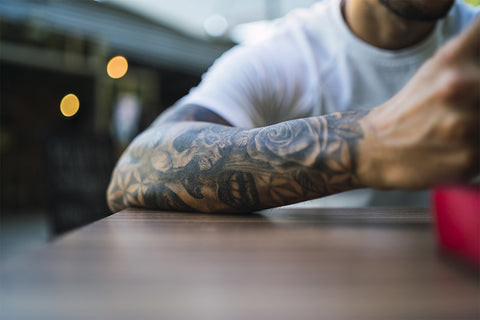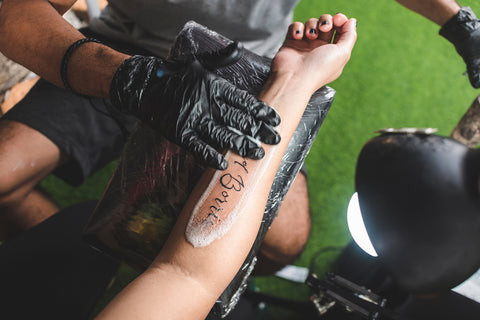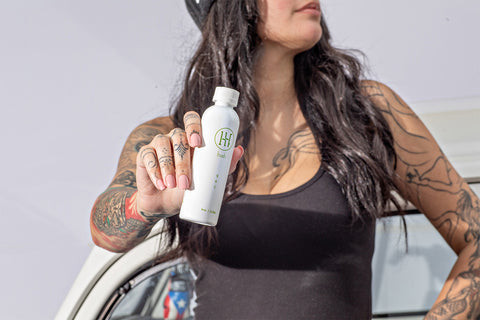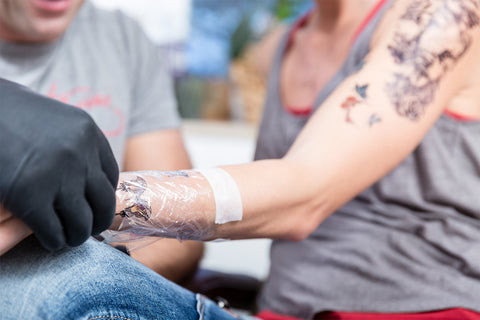Is The Forearm Painful To Tattoo? Generally, forearm tattoos are considered less painful compared to other body parts, but pain is subjective. At tattooat.com, we believe everyone deserves a comfortable tattoo experience, offering insights into pain management, placement options, and aftercare. Explore diverse tattoo designs, find talented artists, and access essential tattoo knowledge on our website, ensuring your body art journey is both stunning and comfortable.
1. How Painful Are Forearm Tattoos?
Forearm tattoos are often cited as some of the least painful tattoos to get. The forearm boasts a good amount of muscle and fewer nerve endings compared to other areas, which helps to buffer the pain. However, pain perception varies greatly from person to person. What one person finds tolerable, another might find quite uncomfortable.
Factors influencing tattoo pain include:
- Individual Pain Tolerance: Everyone experiences pain differently.
- Placement: Certain areas of the forearm can be more sensitive.
- Tattoo Size and Detail: Larger, more detailed tattoos require longer sessions, potentially increasing discomfort.
- Artist Technique: A skilled artist can minimize pain through efficient tattooing.
- Mental State: Anxiety and stress can heighten pain perception.
While many consider forearm tattoos manageable, proper preparation and pain management strategies can further enhance your comfort.
2. What Part of the Forearm Is the Least Painful for a Tattoo?
The outer forearm is generally considered the least painful area for a tattoo. This area has fewer nerve endings and a decent layer of muscle, acting as a cushion.
 Outer Forearm Tattoo
Outer Forearm Tattoo
Here’s a breakdown:
- Outer Forearm: Fewer nerve endings and more muscle make it relatively less sensitive.
- Inner Forearm: Generally more sensitive due to a higher concentration of nerve endings.
- Elbow Area: Both inner and outer elbow areas are more painful due to thin skin and proximity to bone.
If you are concerned about pain, opting for the outer forearm can be a good choice.
3. What About Inner Forearm Tattoo Pain?
The inner forearm tends to be more sensitive than the outer forearm. This area has more nerve endings, making it potentially more painful.
 Outer Forearm Tattoo
Outer Forearm Tattoo
Consider these points regarding inner forearm tattoos:
- Increased Nerve Endings: This area is more sensitive than the outer forearm.
- Skin Sensitivity: Some individuals naturally have more sensitive skin on their inner forearms.
- Elbow Proximity: The closer to the elbow, the more likely you are to experience greater pain.
Despite the increased sensitivity, many people still find inner forearm tattoos manageable, especially with the use of numbing products.
4. How Does a Sleeve Tattoo Affect Pain Levels?
A sleeve tattoo covers a large portion of the arm, encompassing the forearm and often the bicep. Due to the extensive coverage and longer sessions, sleeve tattoos are generally more painful than smaller tattoos.
Factors contributing to the increased pain:
- Longer Sessions: Sleeves require multiple long sessions, leading to prolonged exposure to pain.
- Varied Sensitivity: A sleeve covers areas of varying sensitivity, from the less painful outer forearm to the more sensitive inner arm and elbow.
- Skin Irritation: Extensive tattooing can cause significant skin irritation and inflammation.
However, the ability to break the tattoo into multiple sessions allows the skin time to heal, making the overall experience more manageable.
5. What Tattoo Designs Are Suitable for Forearms?
Forearms are versatile canvases suitable for a wide array of tattoo designs. Popular choices include:
- Quotes: Meaningful quotes can be displayed prominently.
- Armbands: Designs that wrap around the forearm create a striking effect.
- Flowers: Versatile and customizable, flower tattoos can range from simple to intricate.
- Smaller Designs: Arrows, trees, and other small symbols fit well on the forearm.
- Geometric Patterns: Modern and eye-catching, geometric designs are a stylish choice.
 Quote Tattoo
Quote Tattoo
The forearm provides ample space for both simple and complex designs, making it a popular choice for first-timers and experienced tattoo enthusiasts alike.
6. What About Cover-Up Tattoos on the Forearm?
Cover-up tattoos are designed to conceal unwanted or poorly executed tattoos. The forearm is a common area for cover-ups due to its visibility and size.
Key considerations for forearm cover-ups:
- Design Complexity: The new design must be larger and darker than the original to effectively cover it.
- Artist Expertise: An experienced artist is crucial for a successful cover-up.
- Potential Pain: Cover-ups may involve more intense work, potentially increasing pain.
Despite the challenges, a skilled artist can create a beautiful new tattoo that completely transforms the forearm.
7. How Should I Prepare for a Forearm Tattoo Session?
Proper preparation is key to a more comfortable tattoo experience. Here’s what you should do:
- Clean and Shave: Ensure the forearm is clean and free of hair.
- Stay Hydrated: Drink plenty of water in the days leading up to your appointment.
- Eat a Meal: Have a substantial meal before your session to prevent dizziness.
- Relax: Get a good night’s sleep and wear comfortable clothing.
- Consider Numbing Products: Explore topical anesthetics to reduce pain.
Preparing your body and mind can significantly improve your overall experience.
8. How Does Aftercare Affect the Healing of a Forearm Tattoo?
Proper aftercare is essential for ensuring your forearm tattoo heals correctly and remains vibrant.
 Forearm Tattoo Aftercare
Forearm Tattoo Aftercare
Key aftercare steps include:
- Keep It Clean: Gently wash the tattoo with antibacterial soap.
- Moisturize: Apply a tattoo-specific moisturizer to keep the skin hydrated.
- Avoid Sun Exposure: Protect the tattoo from direct sunlight to prevent fading.
- Don’t Scratch: Avoid scratching or picking at the tattoo to prevent infection.
- Follow Artist’s Instructions: Adhere to the specific aftercare guidelines provided by your tattoo artist.
Proper aftercare ensures your tattoo heals beautifully and lasts for years to come.
9. What Role Do Numbing Creams and Gels Play in Forearm Tattoos?
Numbing creams and gels can significantly reduce pain during a tattoo session. These products typically contain lidocaine, a local anesthetic that blocks pain signals.
Benefits of using numbing products:
- Pain Reduction: Reduces discomfort, making the session more tolerable.
- Reduced Anxiety: Helps ease pre-session anxiety associated with pain.
- Longer Sessions: Allows for longer, more detailed tattoo sessions.
- Improved Cooperation: Enables you to sit still, resulting in better tattoo quality.
According to research from Portland State University’s Art Department, in July 2025, topical anesthetics provide a comfortable tattoo experience. Both creams and gels are effective, but creams are often preferred for sensitive skin due to their moisturizing properties.
10. Can Sunscreen Help Preserve Forearm Tattoos?
Yes, sunscreen is crucial for preserving the vibrancy and longevity of forearm tattoos. Sun exposure can cause tattoos to fade and blur over time.
 Sunscreen
Sunscreen
Here’s why sunscreen is important:
- Prevents Fading: Protects the ink from UV rays that cause fading.
- Reduces Blurring: Minimizes the breakdown of ink, keeping lines sharp.
- Protects Skin: Prevents sunburn, which can damage the tattoo and surrounding skin.
Always use a broad-spectrum sunscreen with an SPF of 30 or higher, and reapply frequently, especially when exposed to direct sunlight.
11. Understanding the Tattoo Pain Chart: Forearm Edition
A tattoo pain chart is a visual guide that illustrates the relative pain levels of different body areas during tattooing. The forearm generally falls into the low-to-moderate pain category.
 Outer Forearm Tattoo
Outer Forearm Tattoo
Key points from the pain chart regarding forearms:
- Outer Forearm: Typically rated as low pain due to fewer nerve endings.
- Inner Forearm: Moderate pain due to increased sensitivity.
- Elbow Area: Higher pain levels due to thin skin and bony prominences.
While the pain chart provides a general guideline, individual experiences can vary.
12. What Styles of Tattoos Work Best on the Forearm?
The forearm is a versatile canvas that accommodates various tattoo styles.
- Minimalist Tattoos: Simple designs with clean lines.
- Geometric Tattoos: Patterns and shapes that create a modern aesthetic.
- Watercolor Tattoos: Soft, blended colors that mimic watercolor paintings.
- Traditional Tattoos: Bold lines and classic imagery.
- Realism Tattoos: Highly detailed, lifelike designs.
The choice of style depends on personal preference and the desired aesthetic.
13. Can Hydration Levels Affect Tattoo Pain and Healing on the Forearm?
Yes, staying well-hydrated can positively impact both tattoo pain and healing.
Benefits of hydration:
- Improved Skin Elasticity: Hydrated skin is more pliable, making it easier to tattoo.
- Reduced Pain: Proper hydration can increase pain tolerance.
- Faster Healing: Hydrated skin heals more efficiently.
- Better Ink Absorption: Hydration aids in ink absorption, leading to more vibrant tattoos.
Drink plenty of water in the days leading up to your tattoo appointment and continue to stay hydrated during the healing process.
14. Are There Any Risks Associated With Forearm Tattoos?
While forearm tattoos are generally safe, there are some potential risks to be aware of:
- Infection: Improper hygiene can lead to bacterial infections.
- Allergic Reactions: Allergic reactions to tattoo ink can occur.
- Scarring: Poor aftercare can result in scarring.
- Fading: Sun exposure and improper care can cause tattoos to fade.
- Keloids: Some individuals are prone to developing keloids (raised scars).
Choosing a reputable artist and following proper aftercare guidelines can minimize these risks.
15. Exploring Geometric Tattoo Designs for the Forearm
Geometric tattoos are a popular choice for the forearm, offering a modern and visually appealing aesthetic.
 Quote Tattoo
Quote Tattoo
Key elements of geometric tattoos:
- Symmetry: Balanced and symmetrical designs.
- Shapes: Use of circles, squares, triangles, and other geometric shapes.
- Patterns: Intricate patterns and tessellations.
- Dot Work: Use of dots to create texture and shading.
- Linework: Precise and clean lines.
Geometric tattoos can be customized to fit individual preferences and create unique, eye-catching designs.
16. What Role Does Skin Type Play in Forearm Tattoo Pain?
Skin type can influence pain perception during tattooing.
- Thin Skin: Generally more sensitive, leading to increased pain.
- Thick Skin: Provides more cushioning, potentially reducing pain.
- Sensitive Skin: More prone to irritation and discomfort.
- Dry Skin: Can be more challenging to tattoo and may require extra hydration.
- Oily Skin: Can affect ink absorption and healing.
Understanding your skin type can help you prepare for the tattooing process and manage potential discomfort.
17. How Does the Tattoo Artist’s Skill Affect Pain Levels?
The skill and experience of the tattoo artist can significantly impact pain levels.
A skilled artist will:
- Use Proper Technique: Employ techniques that minimize trauma to the skin.
- Work Efficiently: Complete the tattoo in a timely manner, reducing prolonged exposure to pain.
- Adjust Pressure: Apply appropriate pressure to avoid unnecessary discomfort.
- Provide Guidance: Offer advice on pain management and aftercare.
- Maintain Hygiene: Ensure a clean and sterile environment to prevent infection.
Choosing a reputable and experienced artist is essential for a more comfortable and safe tattoo experience.
18. Can Breathing Techniques Reduce Tattoo Pain on the Forearm?
Yes, practicing breathing techniques can help manage pain during a tattoo session.
Effective techniques include:
- Deep Breathing: Slow, deep breaths can help calm the nervous system.
- Box Breathing: Inhale for four seconds, hold for four seconds, exhale for four seconds, and hold for four seconds.
- Mindful Breathing: Focusing on your breath can help distract you from the pain.
These techniques can help reduce anxiety and promote relaxation, making the tattoo session more manageable.
19. What Are the Best Practices for Long Tattoo Sessions on the Forearm?
Long tattoo sessions require careful planning and preparation.
Best practices include:
- Stay Hydrated: Drink plenty of water to maintain skin elasticity and reduce pain.
- Eat Properly: Have a substantial meal to prevent dizziness and fatigue.
- Take Breaks: Request short breaks to stretch and relax.
- Use Numbing Products: Apply topical anesthetics to minimize pain.
- Communicate With Your Artist: Inform your artist if you need a break or are experiencing excessive discomfort.
Proper preparation and communication can make long tattoo sessions more comfortable and successful.
20. How Does Tattoo Placement Affect Healing Time on the Forearm?
The location of the tattoo on the forearm can affect healing time.
- Outer Forearm: Generally heals faster due to better air circulation and less friction.
- Inner Forearm: May take slightly longer to heal due to increased friction from clothing and body contact.
- Elbow Area: Can take longer to heal due to constant movement and thinner skin.
Proper aftercare and protection can help promote faster healing, regardless of the tattoo’s location on the forearm.
Getting a forearm tattoo is an exciting experience, and understanding the factors that influence pain can help you prepare and manage discomfort. By choosing a skilled artist, following proper aftercare guidelines, and considering pain management options, you can ensure a comfortable and enjoyable tattoo journey.
Ready to explore stunning tattoo designs, find talented artists, and access essential tattoo knowledge? Visit tattooat.com today and start your body art adventure. Discover inspiration for your next tattoo and connect with professionals who can bring your vision to life. Let tattooat.com be your guide to the world of tattoos.
Address: 1825 SW Broadway, Portland, OR 97201, United States.
Phone: +1 (503) 725-3000.
Website: tattooat.com.
FAQ: Is the Forearm Painful to Tattoo?
Q1: Is getting a tattoo on my forearm really that painful?
Forearm tattoos are generally considered less painful than other areas due to the muscle and fewer nerve endings. However, pain is subjective and varies from person to person.
Q2: Which part of the forearm hurts the least for a tattoo?
The outer forearm is typically the least painful spot because it has more muscle and fewer nerve endings.
Q3: What about the inner forearm – is that more painful?
Yes, the inner forearm tends to be more sensitive due to a higher concentration of nerve endings.
Q4: How much more painful is a sleeve tattoo compared to a small forearm tattoo?
Sleeve tattoos are generally more painful because they cover a larger area and require longer sessions, hitting both sensitive and less sensitive areas.
Q5: Can I use numbing cream to reduce the pain of a forearm tattoo?
Yes, numbing creams and gels containing lidocaine can significantly reduce pain during a tattoo session.
Q6: Does skin type affect how painful a forearm tattoo is?
Yes, thinner and more sensitive skin tends to experience more pain than thicker skin.
Q7: How important is aftercare in reducing pain after getting a forearm tattoo?
Proper aftercare is crucial for minimizing discomfort and preventing infection, which can exacerbate pain.
Q8: Does staying hydrated help reduce tattoo pain?
Yes, staying well-hydrated can improve skin elasticity and potentially reduce pain during tattooing.
Q9: Can breathing techniques really help with tattoo pain?
Yes, practicing deep breathing and relaxation techniques can help manage anxiety and reduce pain perception.
Q10: Will sunscreen help with pain or fading of my new forearm tattoo?
Sunscreen won’t directly reduce pain, but it’s essential for preventing fading and protecting the skin, which indirectly contributes to long-term comfort and appearance.
